Analysis of Short-Term Drought Episodes Using Sentinel-3 SLSTR Data under a Semi-Arid Climate in Lower Eastern Kenya
Abstract
1. Introduction
2. Materials and Methods
2.1. Study Area
2.2. Sentinel-3 SLSTR Data
2.2.1. Land Surface Temperature
2.2.2. Fractional Vegetation Cover
2.2.3. Total Column Water Vapor
3. Results and Discussion
3.1. Analysis and Interpretation of ECVs Derived from Sentinel-3 SLSTR Data
3.1.1. Land Surface Temperature (LST)
3.1.2. Fractional Vegetation Cover (FVC)
3.1.3. Total Column Water Vapor (TCWV)
3.1.4. Correlation Analysis among Essential Climatic Variables (ECVs) under Investigation
3.1.5. Density Plots for Correlation between Different Essential Climate Variables
4. Conclusions
Author Contributions
Funding
Data Availability Statement
Acknowledgments
Conflicts of Interest
References
- Rossi, G. Drought Mitigation Measures: A Comprehensive Framework. In Drought and Drought Mitigation in Europe; Vogt, J.V., Somma, F., Eds.; Advances in Natural and Technological Hazards Research; Springer: Dordrecht, The Netherlands, 2000; 14p. [Google Scholar] [CrossRef]
- Musyimi, P.K.; Huho, J.M.; Opiyo, F.E. Understanding Drought Characteristics and Perceived Effects on Water Sources in Kenya’s Drylands: A Case Study of Makindu Sub-County. In Advancing Africa’s Sustainable Development: Proceedings of the 4th Conference on Science Advancement; Fymat, A.L., Kapalanga, J., Eds.; Cambridge Scholars Publishing: Newcastle upon Tyne, UK, 2018; pp. 324–349. ISBN 1-5275-0655-X. [Google Scholar]
- Payus, C.; Huey, L.A.; Adnan, F.; Rimba, A.B.; Mohan, G.; Chapagain, S.K.; Roder, G.; Gasparatos, A.; Fukushi, K. Impact of Extreme Drought Climate on Water Security in North Borneo: Case Study of Sabah. Water 2020, 12, 1135. [Google Scholar] [CrossRef]
- Tabari, H. Climate change impact on flood and extreme precipitation increases with water availability. Sci. Rep. 2020, 10, 13768. [Google Scholar] [CrossRef] [PubMed]
- Dai, H. Roles of Surface Albedo, Surface Temperature and Carbon Dioxide in the Seasonal Variation of Arctic Amplification. Geophys. Res. Lett. 2021, 48, e2020GL090301. [Google Scholar] [CrossRef]
- Wilhite, D.A.; Glantz, M.H. Understanding: The Drought Phenomenon: The Role of Definitions. Water Int. 1985, 10, 111–120. [Google Scholar] [CrossRef]
- Masson-Delmotte, V.P.; Zhai, A.; Pirani, S.L.; Connors, C.; Péan, S.; Berger, N.; Caud, Y.; Chen, L.; Goldfarb, M.I.; Gomis, M.; et al. (Eds.) Climate Change 2021: The Physical Science Basis. Contribution of Working Group I to the Sixth Assessment Report of the Intergovernmental Panel on Climate Change; Cambridge University Press: Cambridge, UK; New York, NY, USA, 2021; Available online: https://report.ipcc.ch/ar6/wg1/IPCC_AR6_WGI_FullReport.pdf (accessed on 6 December 2022).
- Ssenyunzi, R.C.; Oruru, B.; D’ujanga, F.M.; Realini, E.; Barindelli, S.; Tagliaferro, G.; von Engeln, A.; van de Giesen, N. Performance of ERA5 data in retrieving Precipitable Water Vapour over East African tropical region. Adv. Space Res. 2020, 65, 1877–1893. [Google Scholar] [CrossRef]
- Alahacoon, N.; Edirisinghe, M.; Ranagalage, M. Satellite-Based Meteorological and Agricultural Drought Monitoring for Agricultural Sustainability in Sri Lanka. Sustainability 2021, 13, 3427. [Google Scholar] [CrossRef]
- Varghese, D.; Radulović, M.; Stojković, S.; Crnojević, V. Reviewing the Potential of Sentinel-2 in Assessing the Drought. Remote Sens. 2021, 13, 3355. [Google Scholar] [CrossRef]
- Sahbeni, G. A PLSR model to predict soil salinity using Sentinel-2 MSI data. Open Geosci. 2021, 13, 977–987. [Google Scholar] [CrossRef]
- Zanni, S.; De Rosa, A. Remote Sensing Analyses on Sentinel-2 Images: Looking for Roman Roads in Srem Region (Serbia). Geosciences 2019, 9, 25. [Google Scholar] [CrossRef]
- Rousta, I.; Olafsson, H.; Moniruzzaman; Zhang, H.; Liou, Y.-A.; Mushore, T.D.; Gupta, A. Impacts of Drought on Vegetation Assessed by Vegetation Indices and Meteorological Factors in Afghanistan. Remote Sens. 2020, 12, 2433. [Google Scholar] [CrossRef]
- Sahbeni, G. Soil salinity mapping using Landsat 8 OLI data and regression modeling in the Great Hungarian Plain. SN Appl. Sci. 2021, 3, 587. [Google Scholar] [CrossRef]
- Borges, J.; Higginbottom, T.P.; Symeonakis, E.; Jones, M. Sentinel-1 and Sentinel-2 Data for Savannah Land Cover Mapping: Optimising the Combination of Sensors and Seasons. Remote Sens. 2020, 12, 3862. [Google Scholar] [CrossRef]
- Ng, W.-T.; Rima, P.; Einzmann, K.; Immitzer, M.; Atzberger, C.; Eckert, S. Assessing the Potential of Sentinel-2 and Pléiades Data for the Detection of Prosopis and Vachellia spp. in Kenya. Remote Sens. 2017, 9, 74. [Google Scholar] [CrossRef]
- Cheng, Y.; Vrieling, A.; Fava, F.; Meroni, M.; Marshall, M.; Gachoki, S. Phenology of short vegetation cycles in Kenyan rangeland from PlanetScope and Sentinel-2. Remote Sens. Environ. 2020, 248, 112004. [Google Scholar] [CrossRef]
- Hunt, S.E.; Mittaz, J.P.D.; Smith, D.; Polehampton, E.; Yemelyanova, R.; Woolliams, E.R.; Donlon, C. Comparison of the Sentinel-3A and B SLSTR Tandem Phase Data Using Metrological Principles. Remote Sens. 2020, 12, 2893. [Google Scholar] [CrossRef]
- Smith, D.; Hunt, S.E.; Etxaluze, M.; Peters, D.; Nightingale, T.; Mittaz, J.; Woolliams, E.R.; Polehampton, E. Traceability of the Sentinel-3 SLSTR Level-1 Infrared Radiometric Processing. Remote Sens. 2021, 13, 374. [Google Scholar] [CrossRef]
- Jonas, F.; Martin, K.; Daniel, W. Quantifying forest cover at Mount Kenya: Use of Sentinel-2 for a discrimination of tropical tree composites. Afr. J. Environ. Sci. Technol. 2020, 14, 159–176. [Google Scholar] [CrossRef]
- Ghulam, A.; Qin, Q.; Teyip, T.; Li, Z.-L. Modified perpendicular drought index (MPDI): A real-time drought monitoring method. ISPRS J. Photogramm. Remote Sens. 2007, 62, 150–164. [Google Scholar] [CrossRef]
- Jing, X.; Yao, W.-Q.; Wang, J.-H.; Song, X.-Y. A study on the relationship between dynamic change of vegetation coverage and precipitation in Beijing’s mountainous areas during the last 20 years. Math. Comput. Model. 2011, 54, 1079–1085. [Google Scholar] [CrossRef]
- Duveiller, G.; Lopez-Lozano, R.; Cescatti, A. Exploiting the multi-angularity of the MODIS temporal signal to identify spatially homogeneous vegetation cover: A demonstration for agricultural monitoring applications. Remote Sens. Environ. 2015, 166, 61–77. [Google Scholar] [CrossRef]
- Yang, R.; Yu-Lin, D.; Mao, D.; Wang, Z.; Tian, Y.; Dong, Y. Examining Fractional Vegetation Cover Dynamics in Response to Climate from 1982 to 2015 in the Amur River Basin for SDG 13. Sustainability 2020, 12, 5866. [Google Scholar] [CrossRef]
- Mu, B.; Zhao, X.; Zhao, J.; Liu, N.; Si, L.; Wang, Q.; Sun, N.; Sun, M.; Guo, Y.; Zhao, S. Quantitatively Assessing the Impact of Driving Factors on Vegetation in China’s 32 Major Cities. Remote Sens. 2022, 14, 839. [Google Scholar] [CrossRef]
- Kalnay, E.; Cai, M. Impact of urbanization and land-use change on climate. Nature 2003, 423, 528–531. [Google Scholar] [CrossRef]
- Cheng, K.-S.; Su, Y.-F.; Kuo, F.-T.; Hung, W.-C.; Chiang, J.-L. Assessing the effect of landcover changes on air temperature using remote sensing images—A pilot study in northern Taiwan. Landsc. Urban Plan. 2008, 85, 85–96. [Google Scholar] [CrossRef]
- Amiri, R.; Weng, Q.; Alimohammadi, A.; Alavipanah, S.K. Spatial–temporal dynamics of land surface temperature in relation to fractional vegetation cover and land use/cover in the Tabriz urban area, Iran. Remote Sens. Environ. 2009, 113, 2606–2617. [Google Scholar] [CrossRef]
- Lai, Y.-J.; Li, C.-F.; Lin, P.-H.; Wey, T.-H.; Chang, C.-S. Comparison of MODIS land surface temperature and ground-based observed air temperature in complex topography. Int. J. Remote Sens. 2012, 33, 7685–7702. [Google Scholar] [CrossRef]
- Zhang, D.; Tang, R.; Zhao, W.; Tang, B.; Wu, H.; Shao, K.; Li, Z.-L. Surface Soil Water Content Estimation from Thermal Remote Sensing based on the Temporal Variation of Land Surface Temperature. Remote Sens. 2014, 6, 3170–3187. [Google Scholar] [CrossRef]
- Harris, P.P.; Folwell, S.S.; Gallego-Elvira, B.; Rodríguez, J.; Milton, S.; Taylor, C.M. An Evaluation of Modeled Evaporation Regimes in Europe Using Observed Dry Spell Land Surface Temperature. J. Hydrometeorol. 2017, 18, 1453–1470. [Google Scholar] [CrossRef]
- Metz, M.; Andreo, V.; Neteler, M. A New Fully Gap-Free Time Series of Land Surface Temperature from MODIS LST Data. Remote Sens. 2017, 9, 1333. [Google Scholar] [CrossRef]
- Mustafa, E.K.; El-Hamid, H.T.A.; Tarawally, M. Spatial and temporal monitoring of drought based on land surface temperature, Freetown City, Sierra Leone, West Africa. Arab. J. Geosci. 2021, 14, 1013. [Google Scholar] [CrossRef]
- Mustafa, E.K.; Liu, G.; El-Hamid, H.T.A.; Kaloop, M.R. Simulation of land use dynamics and impact on land surface temperature using satellite data. GeoJournal 2021, 86, 1089–1107. [Google Scholar] [CrossRef]
- Grossi, M.; Valks, P.; Loyola, D.; Aberle, B.; Slijkhuis, S.; Wagner, T.; Beirle, S.; Lang, R. Total column water vapour measurements from GOME-2 MetOp-A and MetOp-B. Atmos. Meas. Tech. 2015, 8, 1111–1133. [Google Scholar] [CrossRef]
- Namaoui, H.; Kahlouche, S.; Belbachir, A.H.; Van Malderen, R.; Brenot, H.; Pottiaux, E. GPS water vapor and its comparison with radiosonde and ERA-Interim data in Algeria. Adv. Atmos. Sci. 2017, 34, 623–634. [Google Scholar] [CrossRef]
- Lindstrot, R.; Stengel, M.; Schröder, M.; Fischer, J.; Preusker, R.; Schneider, N.; Steenbergen, T.; Bojkov, B.R. A global climatology of total columnar water vapour from SSM/I and MERIS. Earth Syst. Sci. Data 2014, 6, 221–233. [Google Scholar] [CrossRef]
- GoK. Republic of Kenya. Economic Survey, 2013. Kenya National Bureau of Statistics (KNBS), Nairobi, Kenya. 2013. Available online: https://academia-ke.org/library/download/knbs-kenya-economic-survey-2013-january-2014/?wpdmdl=7734&refresh=62053100c470c1644507392 (accessed on 7 November 2022).
- Wanyama, D.; Moore, N.J.; Dahlin, K.M. Persistent Vegetation Greening and Browning Trends Related to Natural and Human Activities in the Mount Elgon Ecosystem. Remote Sens. 2020, 12, 2113. [Google Scholar] [CrossRef]
- Muema, E.; Mburu, J.; Coulibaly, J.; Mutune, J. Determinants of access and utilisation of seasonal climate information services among smallholder farmers in Makueni County, Kenya. Heliyon 2018, 4, e00889. [Google Scholar] [CrossRef]
- GoK. Kenya Population and Housing Census Volume I: Population by County and Sub-County. Government Printer. 2019. Available online: https://www.knbs.or.ke/?wpdmpro=2019-kenya-population-and-housing-census-volume-i-population-by-county-and-sub-county (accessed on 7 November 2022).
- Akuja, T.E.; Kandagor, J. A review of policies and agricultural productivity in the arid and semi-arid lands (ASALS), Kenya: The case of Turkana County. J. Appl. Biosci. 2019, 140, 14304. [Google Scholar] [CrossRef]
- CCKP (Climate Change Knowledge Portal). Kenya Projected Future Climate. URL. 2020. Available online: https://climateknowledgeportal.worldbank.org/country/Kenya/climate-data-projections (accessed on 10 October 2022).
- Marshall, M.T.; Funk, C.; Michaelsen, J. Agricultural Drought Monitoring in Kenya Using Evapotranspiration Derived from Remote Sensing and Reanalysis Data. In Remote Sensing of Drought: Innovative Monitoring Approaches; Wardlow, B.D., Anderson, M.C., Verdin, J.P., Eds.; CRC Press/Taylor & Francis: Boca Raton, FL, USA, 2012; pp. 169–193. Available online: http://digitalcommons.unl.edu/usgsstaffpub/978 (accessed on 1 September 2022).
- Huho, J.M.; Mashara, J.N.; Musyimi, P.K. Profiling Disasters in Kenya and their causes. Acad. Res. Int. J. 2016, 7, 290–305. Available online: http://www.savap.org.pk/journals/ARInt./Vol.7(1)/2016(7.1-30).pdf (accessed on 10 November 2022).
- Downing, T.; Watkiss, P.; Dyszynski, J.; Butterfield, R.; Devisscher, T.; Pye, S.; Sang, J. The Economics of Climate Change in Kenya: Final Report Submitted in Advance of COP15. 2009. Available online: https://mediamanager.sei.org/documents/Publications/SEI-ProjectReport-Downing-EconomicsOfClimateChangeKenya-2009.pdf (accessed on 2 February 2023).
- Ajuang, C.O.; Abuom, P.O.; Bosire, E.K.; Dida, G.O.; Anyona, D.N. Determinants of climate change awareness level in upper Nyakach Division, Kisumu County, Kenya. Springer Plus 2016, 5, 1015. [Google Scholar] [CrossRef]
- Huho, J.M. An Analysis of Rainfall Characteristics in Machakos County, Kenya. IOSR J. Environ. Sci. Toxicol. Food Technol. 2017, 11, 64–72. [Google Scholar] [CrossRef]
- Maguta, J.K.; Nzengya, D.M.; Mutisya, C.; Wairimu, J. Building Capacity to Cope with Climate change-induced Resource-Based Conflicts among Grassroots Communities in Kenya. In African Handbook of Climate Change Adaptation; Leal Filho, W., Oguge, N., Ayal, D., Adeleke, L., da Silva, I., Eds.; Springer: Cham, Swizerland, 2021; pp. 2611–2630. [Google Scholar] [CrossRef]
- Indiatsy, C.M. Analysis of Historical Monthly, Seasonal and Annual Rainfall Variability (1990–2014) in Machakos Sub County, Kenya. Int. J. Multidiscip. Curr. Res. 2018, 6, 21–41. [Google Scholar] [CrossRef]
- Musyimi, P.K.; Huho, J.M.; Nduru, G.M.; Opiyo, F.E. Assessment of Suitability of Adaptation Strategies to Water Scarcity in Makindu Sub-County, Kenya. Acad. Res. Int. 2017, 8, 115–123. Available online: http://www.savap.org.pk/journals/ARInt./Vol.8(2)/ARInt.2017(8.2-11).pdf (accessed on 10 September 2022).
- Khisa, G.V. Peoples’ perception on climate change and its effects on livelihood in Kitui County. Int. J. Sustain. Dev. Plan. 2018, 7, 70–81. Available online: https://isdsnet.com/ijds-v7n1-05.pdf (accessed on 10 November 2022).
- Mutunga, E.J.; Ndungu, C.K.; Muendo, P. Smallholder Farmers’ Perceptions and Adaptations to Climate Change and Variability in Kitui County, Kenya. J. Earth Sci. Clim. Chang. 2017, 8, 389. [Google Scholar]
- Mwangi, M.; Kituyi, E.; Ouma, G.; Macharia, D. Indicator Approach to Assessing Climate Change Vulnerability of Communities in Kenya: A Case Study of Kitui County. Am. J. Clim. Chang. 2020, 9, 53–67. [Google Scholar] [CrossRef]
- Ogallo, L.; Omay, P.; Kabaka, G.; Lutta, I. Report on Historical Climate Baseline Statistics for Taita Taveta, Kenya Vol. 1; IGAD Climate Prediction and Application Centre: Ngong, Kenya, 2019. [Google Scholar] [CrossRef]
- Autio, A.; Johansson, T.; Motaroki, L.; Minoia, P.; Pellikka, P. Constraints for adopting climate-smart agricultural practices among smallholder farmers in Southeast Kenya. Agric. Syst. 2021, 194, 103284. [Google Scholar] [CrossRef]
- ESA. Sentinel-3 SLSTR User Guide. 2022. Available online: https://sentinel.esa.int/web/sentinel/user-guides/sentinel-3-slstr (accessed on 1 September 2022).
- Coppo, P.; Ricciarelli, B.; Brandani, F.; Delderfield, J.; Ferlet, M.; Mutlow, C.; Munro, G.; Nightingale, T.; Smith, D.; Bianchi, S.; et al. SLSTR: A high accuracy dual scan temperature radiometer for sea and land surface monitoring from space. J. Mod. Opt. 2010, 57, 1815–1830. [Google Scholar] [CrossRef]
- Yang, J.; Zhou, J.; Göttsche, F.-M.; Long, Z.; Ma, J.; Luo, R. Investigation and validation of algorithms for estimating land surface temperature from Sentinel-3 SLSTR data. Int. J. Appl. Earth Obs. Geoinf. 2021, 91, 102136. [Google Scholar] [CrossRef]
- Wooster, M.; Xu, W.; Nightingale, T. Sentinel-3 SLSTR active fire detection and FRP product: Pre-launch algorithm development and performance evaluation using MODIS and ASTER datasets. Remote Sens. Environ. 2012, 120, 236–254. [Google Scholar] [CrossRef]
- King, J.A.; Washington, R.; Engelstaedter, S. Representation of the Indian Ocean Walker circulation in climate models and links to Kenyan rainfall. Int. J. Clim. 2020, 41, E616–E643. [Google Scholar] [CrossRef]
- Kustas, W.; Anderson, M. Advances in thermal infrared remote sensing for land surface modeling. Agric. For. Meteorol. 2009, 149, 2071–2081. [Google Scholar] [CrossRef]
- Li, Z.-L.; Tang, B.-H.; Wu, H.; Ren, H.; Yan, G.; Wan, Z.; Trigo, I.F.; Sobrino, J.A. Satellite-derived land surface temperature: Current status and perspectives. Remote Sens. Environ. 2013, 131, 14–37. [Google Scholar] [CrossRef]
- ESA. User Guides: Sentinel-3 SLSTR. 2021. Available online: https://sentinels.copernicus.eu/web/sentinel/user-guides/sentinel-3-slstr/overview/geophysical-measurements/land-surface-temperature (accessed on 1 September 2022).
- Meng, X.; Cheng, J.; Liang, S. Estimating Land Surface Temperature from Feng Yun-3C/MERSI Data Using a New Land Surface Emissivity Scheme. Remote Sens. 2017, 9, 1247. [Google Scholar] [CrossRef]
- Solanky, V.; Singh, S.; Katiyar, S.K. Land Surface Temperature Estimation Using Remote Sensing Data. In Hydrologic Modeling. Water Science and Technology Library, 81; Singh, V., Yadav, S., Yadava, R., Eds.; Springer: Singapore, 2018. [Google Scholar] [CrossRef]
- Dar, I.; Qadir, J.; Shukla, A. Estimation of LST from multi-sensor thermal remote sensing data and evaluating the influence of sensor characteristics. Ann. GIS 2019, 25, 263–281. [Google Scholar] [CrossRef]
- Vlassova, L.; Perez-Cabello, F.; Nieto, H.; Martín, P.; Riaño, D.; De La Riva, J. Assessment of Methods for Land Surface Temperature Retrieval from Landsat-5 TM Images Applicable to Multiscale Tree-Grass Ecosystem Modeling. Remote Sens. 2014, 6, 4345–4368. [Google Scholar] [CrossRef]
- Carlson, T.N.; Ripley, D.A. On the relation between NDVI, fractional vegetation cover, and leaf area index. Remote Sens. Environ. 1997, 62, 241–252. [Google Scholar] [CrossRef]
- Gao, L.; Wang, X.; Johnson, B.A.; Tian, Q.; Wang, Y.; Verrelst, J.; Mu, X.; Gu, X. Remote sensing algorithms for estimation of fractional vegetation cover using pure vegetation index values: A review. ISPRS J. Photogramm. Remote Sens. 2020, 159, 364–377. [Google Scholar] [CrossRef]
- Lawley, E.F.; Lewis, M.M.; Ostendorf, B. Evaluating MODIS soil fractional cover for arid regions, using albedo from high-spatial resolution satellite imagery. Int. J. Remote Sens. 2014, 35, 2028–2046. [Google Scholar] [CrossRef]
- Sun, Y.; Ren, H.; Zhou, G.; Zhang, T.; Zhang, C.Y.; Qin, Q. The estimation and validation of fractional vegetation cover based on GaoFen-4 satellite imagery. In Proceedings of the 2017 IEEE International Geoscience and Remote Sensing Symposium (IGARSS), Fort Worth, TX, USA, 23–28 July 2017; pp. 3495–3498. [Google Scholar] [CrossRef]
- Rouse, J.W.; Haas, R.H.; Schell, J.A.; Deering, D.W. Monitoring vegetation systems in the Great Plains with ERTS, In Third Earth Resources Technology Satellite–1 Syposium. Volume I: Technical Presentations; Freden, S.C., Mercanti, E.P., Becker, M., Eds.; NASA SP-351; NASA: Washington, DC, USA, 1974; pp. 309–317. [Google Scholar]
- Qi, J.; Marsett, R.; Moran, M.; Goodrich, D.; Heilman, P.; Kerr, Y.; Dedieu, G.; Chehbouni, A.; Zhang, X. Spatial and temporal dynamics of vegetation in the San Pedro River basin area. Agric. For. Meteorol. 2000, 105, 55–68. [Google Scholar] [CrossRef]
- Wu, C.; Murray, A.T. Estimating impervious surface distribution by spectral mixture analysis. Remote Sens. Environ. 2003, 84, 493–505. [Google Scholar] [CrossRef]
- Gutman, G.; Ignatov, A. The derivation of the green vegetation fraction from NOAA/AVHRR data for use in numerical weather prediction models. Int. J. Remote Sens. 1998, 19, 1533–1543. [Google Scholar] [CrossRef]
- Jiménez-Muñoz, J.C.; Sobrino, J.A.; Plaza, A.; Guanter, L.; Moreno, J.; Martínez, P. Comparison between fractional vegetation cover retrievals from vegetation indices and spectral mixture analysis: Case study of PROBA/CHRIS data over an agricultural area. Sensors 2009, 9, 768–793. [Google Scholar] [CrossRef] [PubMed]
- Chahine, M.T. The hydrological cycle and its influence on climate. Nature 1992, 359, 373–380. [Google Scholar] [CrossRef]
- Lacis, A.A.; Schmidt, G.A.; Rind, D.; Ruedy, R.A. Atmospheric CO2: Principal Control Knob Governing Earth’s Temperature. Science 2010, 330, 356–359. [Google Scholar] [CrossRef]
- Zhao, Y.; Zhou, T. Asian water tower evinced in total column water vapor: A comparison among multiple satellite and reanalysis data sets. Clim. Dyn. 2020, 54, 231–245. [Google Scholar] [CrossRef]
- Abbasi, B.; Qin, Z.; Du, W.; Fan, J.; Zhao, C.; Hang, Q.; Zhao, S.; Li, S. An Algorithm to Retrieve Total Precipitable Water Vapor in the Atmosphere from FengYun 3D Medium Resolution Spectral Imager 2 (FY-3D MERSI-2) Data. Remote Sens. 2020, 12, 3469. [Google Scholar] [CrossRef]
- Wypych, A.; Bochenek, B.; Różycki, M. Atmospheric Moisture Content over Europe and the Northern Atlantic. Atmosphere 2018, 9, 18. [Google Scholar] [CrossRef]
- Banimahd, S.; Zand-Parsa, S. Simulation of evaporation, coupled liquid water, water vapor and heat transport through the soil medium. Agric. Water Manag. 2013, 130, 168–177. [Google Scholar] [CrossRef]
- EUMeTrain. Product Tutorial on TPW Content Products. 2014. Available online: http://www.eumetrain.org/data/3/359/navmenu.php?tab=2&page=1.0.0 (accessed on 20 November 2022).
- Kitui County Integrated Development Plan (CIDP), 2018–2022: Kitui County Integrated Development Plan. 2018. Available online: https://repository.kippra.or.ke/handle/123456789/587 (accessed on 1 September 2022).
- Guha, S.; Govil, H.; Besoya, M. An investigation on seasonal variability between LST and NDWI in an urban environment using Landsat satellite data. Geomat. Nat. Hazards Risk 2020, 11, 1319–1345. [Google Scholar] [CrossRef]
- Mwangi, P.W.; Karanja, F.N.; Kamau, P.K. Analysis of the Relationship between Land Surface Temperature and Vegetation and Built-Up Indices in Upper-Hill, Nairobi. J. Geosci. Environ. Prot. 2018, 6, 1–16. [Google Scholar] [CrossRef]
- Panda, S.K.; Choudhury, S.; Saraf, A.K.; Das, J.D. MODIS land surface temperature data detects thermal anomaly preceding 8 October 2005 Kashmir earthquake. Int. J. Remote Sens. 2007, 28, 4587–4596. [Google Scholar] [CrossRef]
- Vancutsem, C.; Ceccato, P.; Dinku, T.; Connor, S.J. Evaluation of MODIS land surface temperature data to estimate air temperature in different ecosystems over Africa. Remote Sens. Environ. 2010, 114, 449–465. [Google Scholar] [CrossRef]
- Amantai, N.; Ding, J. Analysis on the Spatio-Temporal Changes of LST and Its Influencing Factors Based on VIC Model in the Arid Region from 1960 to 2017: An Example of the Ebinur Lake Watershed, Xinjiang, China. Remote Sens. 2021, 13, 4867. [Google Scholar] [CrossRef]
- Ahmed, B.; Kamruzzaman, M.; Zhu, X.; Rahman, M.S.; Choi, K. Simulating Land Cover Changes and Their Impacts on Land Surface Temperature in Dhaka, Bangladesh. Remote Sens. 2013, 5, 5969–5998. [Google Scholar] [CrossRef]
- Kok, J.F.; Ward, D.S.; Mahowald, N.M.; Evan, A.T. Global and regional importance of the direct dust-climate feedback. Nat. Commun. 2018, 9, 241. [Google Scholar] [CrossRef] [PubMed]
- Cui, Y.Y.; de Foy, B. Seasonal Variations of the Urban Heat Island at the Surface and the Near-Surface and Reductions due to Urban Vegetation in Mexico City. J. Appl. Meteorol. Clim. 2012, 51, 855–868. [Google Scholar] [CrossRef]
- Li, R.; Wang, C.; Wu, D. Changes in precipitation recycling over arid regions in the Northern Hemisphere. Theor. Appl. Clim. 2018, 131, 489–502. [Google Scholar] [CrossRef]
- Faramarzi, M.; Heidarizadi, Z.; Mohamadi, A.; Heydari, M. Detection of vegetation changes in relation to normalized difference vegetation index (NDVI) in semi-arid rangeland in western Iran. J. Agric. Sci. Technol. 2018, 20, 51–60. Available online: https://jast.modares.ac.ir/article-23-10153-en.pdf (accessed on 10 October 2022).
- Yang, T.; Ala, M.; Zhang, Y.; Wu, J.; Wang, A.; Guan, D. Characteristics of soil moisture under different vegetation coverage in Horqin Sandy Land, northern China. PLoS ONE 2018, 13, e0198805. [Google Scholar] [CrossRef] [PubMed]
- Ji, F.; Wu, Z.; Huang, J.; Chassignet, E.P. Evolution of land surface air temperature trend. Nat. Clim. Chang. 2014, 4, 462–466. [Google Scholar] [CrossRef]
- Qiao, R.; Dong, C.; Ji, S.; Chang, X. Spatial Scale Effects of the Relationship between Fractional Vegetation Coverage and Land Surface Temperature in Horqin Sandy Land, North China. Sensors 2021, 21, 6914. [Google Scholar] [CrossRef] [PubMed]
- Rahimzadeh-Bajgiran, P.; Omasa, K.; Shimizu, Y. Comparative Evaluation of the Vegetation Dryness Index (VDI), the Temperature Vegetation Dryness Index (TVDI) and the Improved TVDI (iTVDI) for Water Stress Detection in Semi-Arid Regions of Iran. ISPRS-J. Photogramm. Remote Sens. 2012, 68, 1–12. [Google Scholar] [CrossRef]
- Holzman, M.E.; Rivas, R.; Piccolo, M.C. Estimating Soil Moisture and the Relationship with Crop Yield Using Surface Temperature and Vegetation Index. Int. J. Appl. Earth Obs. Geoinf. 2014, 28, 181–192. [Google Scholar] [CrossRef]
- Areffian, A.; Eslamian, S.; Sadr, M.K.; Khoshfetrat, A. Monitoring the Effects of Drought on Vegetation Cover and Ground Water Using MODIS Satellite Images and ANN. KSCE J. Civ. Eng. 2021, 25, 1095–1105. [Google Scholar] [CrossRef]
- EUMETSAT. Available online: https://navigator.eumetsat.int/product/EO:EUM:DAT:MSG:FVC-SEVIRI/print.2017 (accessed on 29 May 2023).
- Musau, M.; Mugo, J. Anthropogenic influences on species composition and diversity dryland forest fragments Kitui, Eastern Kenya. East Afr. Agric. For. J. 2021, 84, 181–194. Available online: https://www.kalro.org/www.eaafj.or.ke/index.php/path/issue/view/44 (accessed on 7 December 2022).
- UNEP. Global Environment Outlook. Environment for Development. Nairobi, Kenya, 2007. Available online: https://wedocs.unep.org/handle/20.500.11822/7646;jsessionid=166F1A4FA202BB68319E13938C492226 (accessed on 7 December 2022).
- Archibald, S.; Scholes, R.J. Leaf green-up in a semi-arid African savanna separating tree and grass responses to environmental cues. J. Veg. Sci. 2007, 18, 583–594. Available online: http://www.jstor.org/stable/4499264 (accessed on 10 January 2023).
- Guo, B.; Zhang, J.; Meng, X.; Xu, T.; Song, Y. Long-term spatio-temporal precipitation variations in China with precipitation surface interpolated by ANUSPLIN. Sci. Rep. 2020, 10, 1–17. [Google Scholar] [CrossRef]
- Nguyen, T.T. Fractional Vegetation Cover Change Detection In Megacities Using Landsat Time-Series Images: A Case Study Of Hanoi City (Vietnam) During 1986–2019. Geogr. Environ. Sustain. 2019, 12, 175–187. [Google Scholar] [CrossRef]
- Zhang, S.; Chen, H.; Fu, Y.; Niu, H.; Yang, Y.; Zhang, B. Fractional Vegetation Cover Estimation of Different Vegetation Types in the Qaidam Basin. Sustainability 2019, 11, 864. [Google Scholar] [CrossRef]
- Xie, L.; Meng, X.; Zhao, X.; Fu, L.; Sharma, R.P.; Sun, H. Estimating Fractional Vegetation Cover Changes in Desert Regions Using RGB Data. Remote Sens. 2022, 14, 3833. [Google Scholar] [CrossRef]
- Sahbeni, G.; Pleynet, J.B.; Jarocki, K. A spatiotemporal analysis of precipitation anomalies using rainfall Gini index between 1980 and 2022. Atmos. Sci. Lett. 2023, 24, e1161. [Google Scholar] [CrossRef]
- Taylor, C.; Lambin, E.F.; Stephenne, N.; Harding, R.J.; Essery, R. The Influence of Land Use Change on Climate in the Sahel. J. Clim. 2002, 15, 3615–3629. [Google Scholar] [CrossRef]
- Duguay-Tetzlaff, A.; Bento, V.A.; Göttsche, F.M.; Stöckli, R.; Martins, J.P.A.; Trigo, I.; Olesen, F.; Bojanowski, J.S.; Da Camara, C.; Kunz, H. Meteosat Land Surface Temperature Climate Data Record: Achievable Accuracy and Potential Uncertainties. Remote Sens. 2015, 7, 13139–13156. [Google Scholar] [CrossRef]
- Trenberth, K.E.; Caron, J.M. The Southern Oscillation Revisited: Sea Level Pressures, Surface Temperatures, and Precipitation. J. Clim. 2000, 13, 4358–4365. [Google Scholar] [CrossRef]
- Trenberth, K.E. Changes in precipitation with climate change, Contribution to CR Special 25’ Climate services for sustainable development. Clim. Res. 2011, 47, 123–138. [Google Scholar] [CrossRef]
- Holloway, C.; Neelin, J.D. Temporal Relations of Column Water Vapor and Tropical Precipitation. J. Atmos. Sci. 2010, 67, 1091–1105. [Google Scholar] [CrossRef]
- Borger, C.; Beirle, S.; Wagner, T. Analysis of global trends of total column water vapour from multiple years of OMI observations. Atmos. Chem. Phys. 2022, 22, 10603–10621. [Google Scholar] [CrossRef]
- Wang, J.; Dai, A.; Mears, C. Global Water Vapor Trend from 1988 to 2011 and Its Diurnal Asymmetry Based on GPS, Radiosonde, and Microwave Satellite Measurements. J. Climate 2016, 29, 5205–5222. [Google Scholar] [CrossRef]
- Neelin, J.D.; Martinez-Villalobos, C.; Stechmann, S.N.; Ahmed, F.; Chen, G.; Norris, J.M.; Kuo, Y.-H.; Lenderink, G. Precipitation Extremes and Water Vapor. Curr. Clim. Chang. Rep. 2022, 8, 17–33. [Google Scholar] [CrossRef]
- Gomes, Y.B.; Caracristi, I. Seasonal analysis on land surface temperature (LST) and normalized difference vegetation index (NDVI) variations in the Iguatu semi-arid hinterland, ceará. Int. J. Hydrol. 2021, 5, 289–294. [Google Scholar] [CrossRef]
- Marajh, L.; He, Y. Temperature Variation and Climate Resilience Action within a Changing Landscape. Remote Sens. 2022, 14, 701. [Google Scholar] [CrossRef]
- Mao, P.; Zhang, J.; Li, M.; Liu, Y.; Wang, X.; Yan, R.; Shen, B.; Zhang, X.; Shen, J.; Zhu, X.; et al. Spatial and temporal variations in fractional vegetation cover and its driving factors in the Hulun Lake region. Ecol. Indic. 2022, 135, 108490. [Google Scholar] [CrossRef]
- Xin, Z.B.; Xu, J.X.; Zheng, W. Spatiotemporal variations of vegetation cover on the Chinese Loess Plateau (1981–2006): Impacts of climate changes and human activities. Sci. China Ser. D Earth Sci. 2008, 51, 67–78. [Google Scholar] [CrossRef]
- Küçük, Ç.; Koirala, S.; Carvalhais, N.; Miralles, D.G.; Reichstein, M.; Jung, M. Characterizing the Response of Vegetation Cover to Water Limitation in Africa Using Geostationary Satellites. J. Adv. Model. Earth Syst. 2022, 14, e2021MS002730. [Google Scholar] [CrossRef] [PubMed]
- Yang, G.; Pu, R.; Zhang, J.; Zhao, C.; Feng, H.; Wang, J. Remote sensing of seasonal variability of fractional vegetation cover and its object-based spatial pattern analysis over mountain areas. ISPRS J. Photogramm. Remote Sens. 2013, 77, 79–93. [Google Scholar] [CrossRef]
- Li, M.; Zhong, S.; Luo, Y.; Liu, Q.; Li, X. A Study of the Change in Surface Parameters during the Last Four Decades in the MuUs Desert Based on Remote Sensing Data. Remote Sens. 2022, 14, 4025. [Google Scholar] [CrossRef]
- Li, Y.L.; Wang, X.Q.; Chen, Y.Z.; Wang, M.M. The correlation analysis of land surface temperature and fractional vegetation coverage in Fujian province. J. Geo-Inf. Sci. 2019, 21, 445–454. Available online: http://www.dqxxkx.cn/EN/10.12082/dqxxkx.2019.180316 (accessed on 10 January 2023).
- Shivers, S.W.; Roberts, D.A.; McFadden, J.P.; Tague, C. An analysis of atmospheric water vapor variations over a complex agricultural region using airborne imaging spectrometry. PLoS ONE 2019, 14, e0226014. [Google Scholar] [CrossRef]
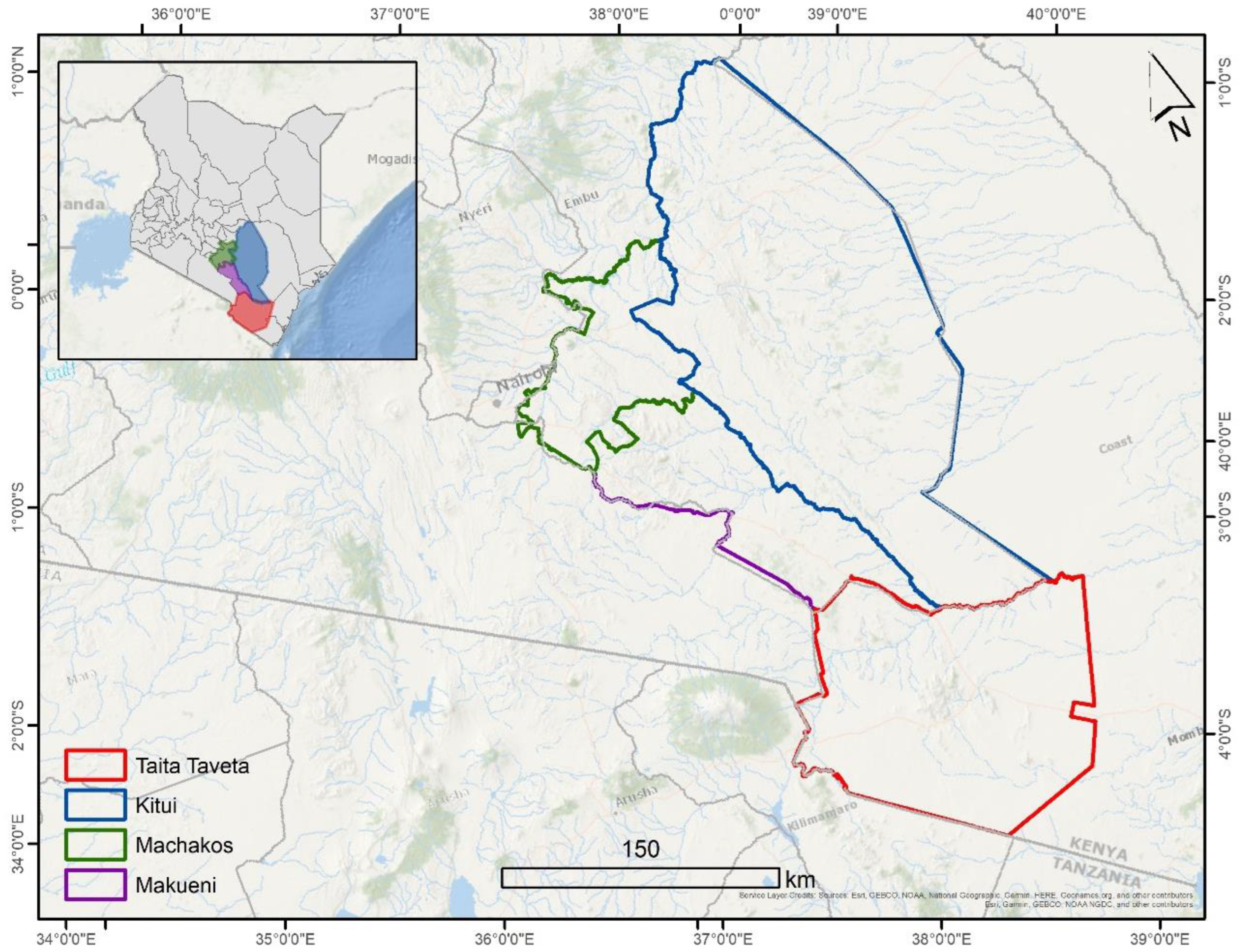

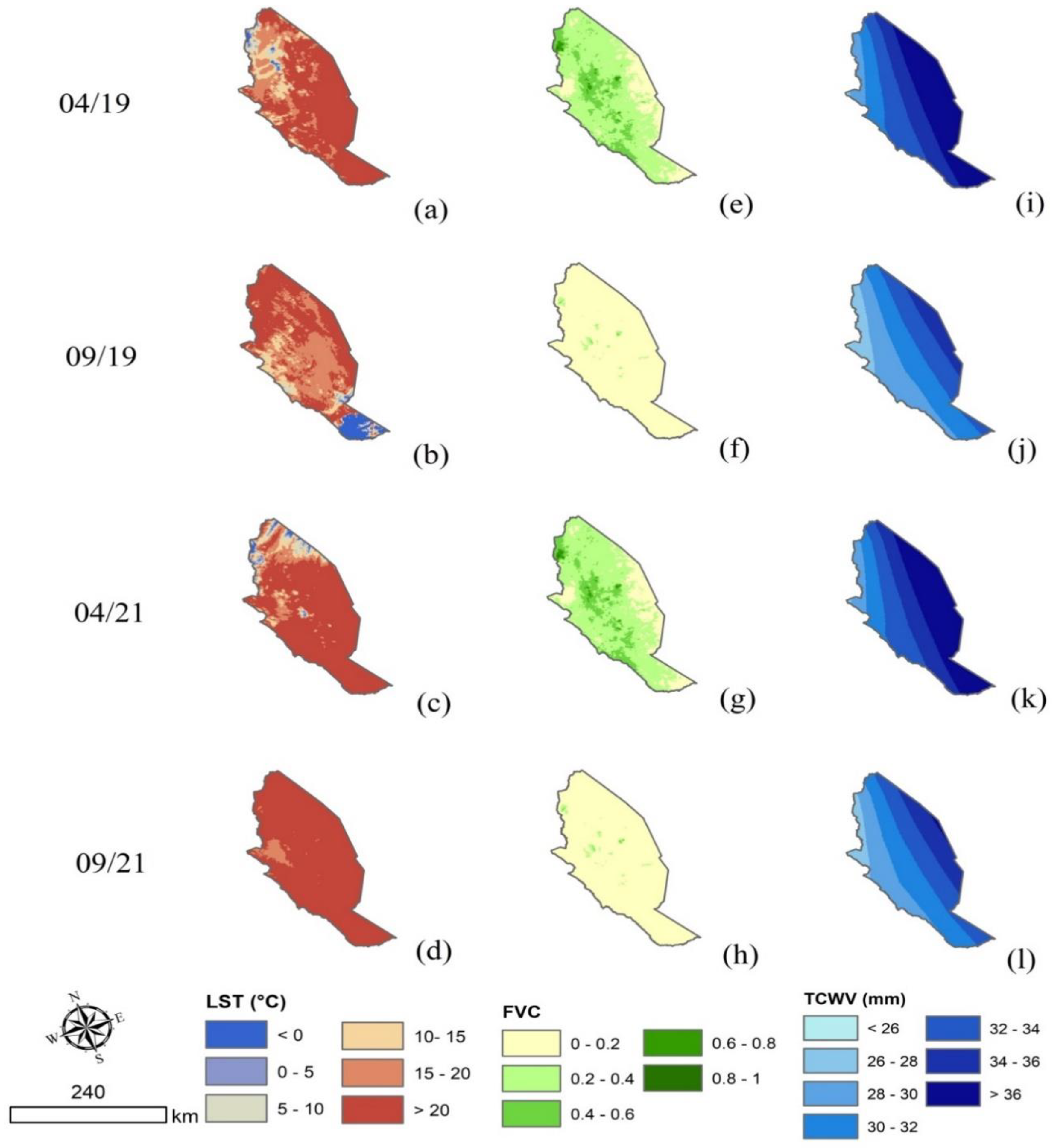
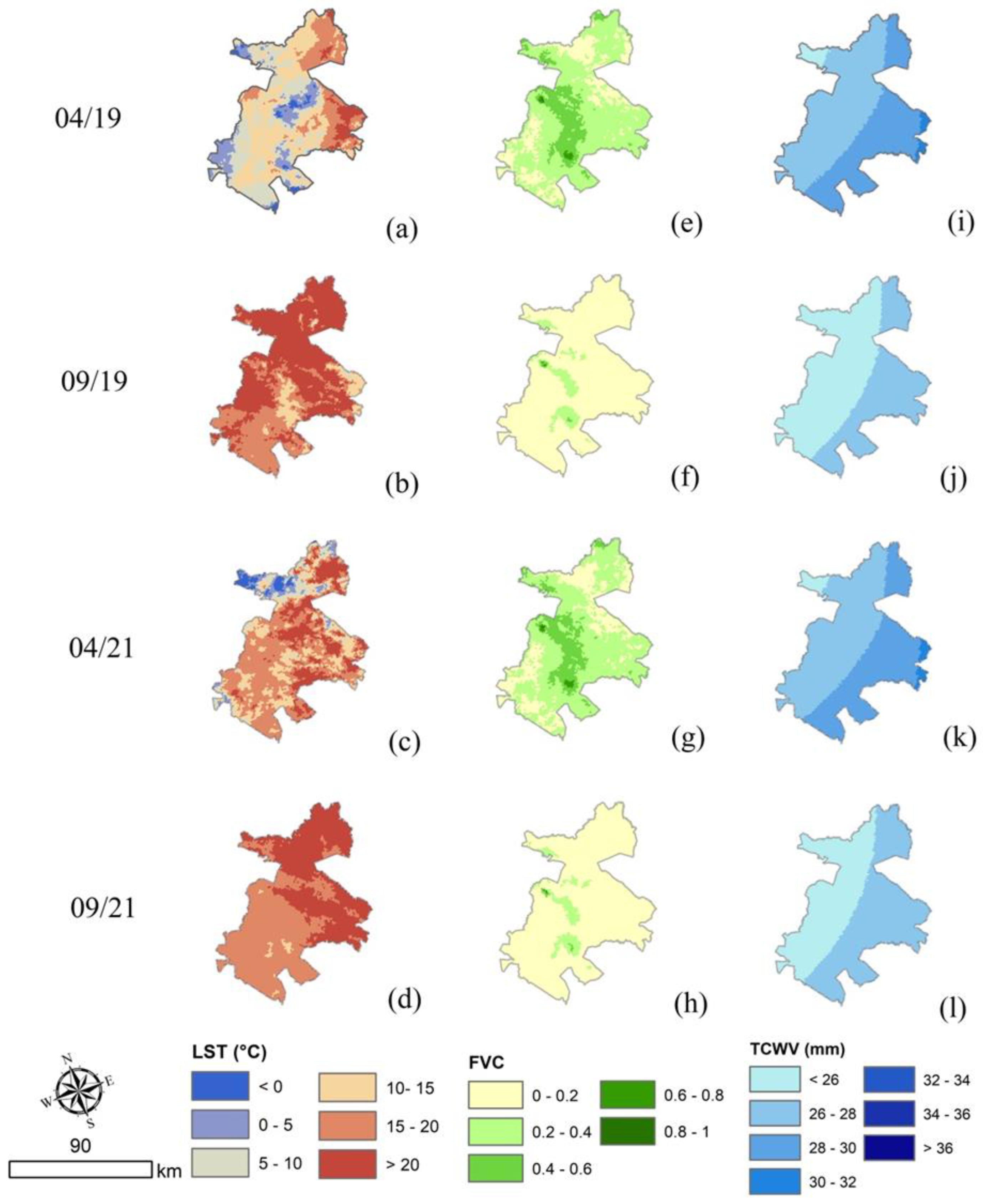
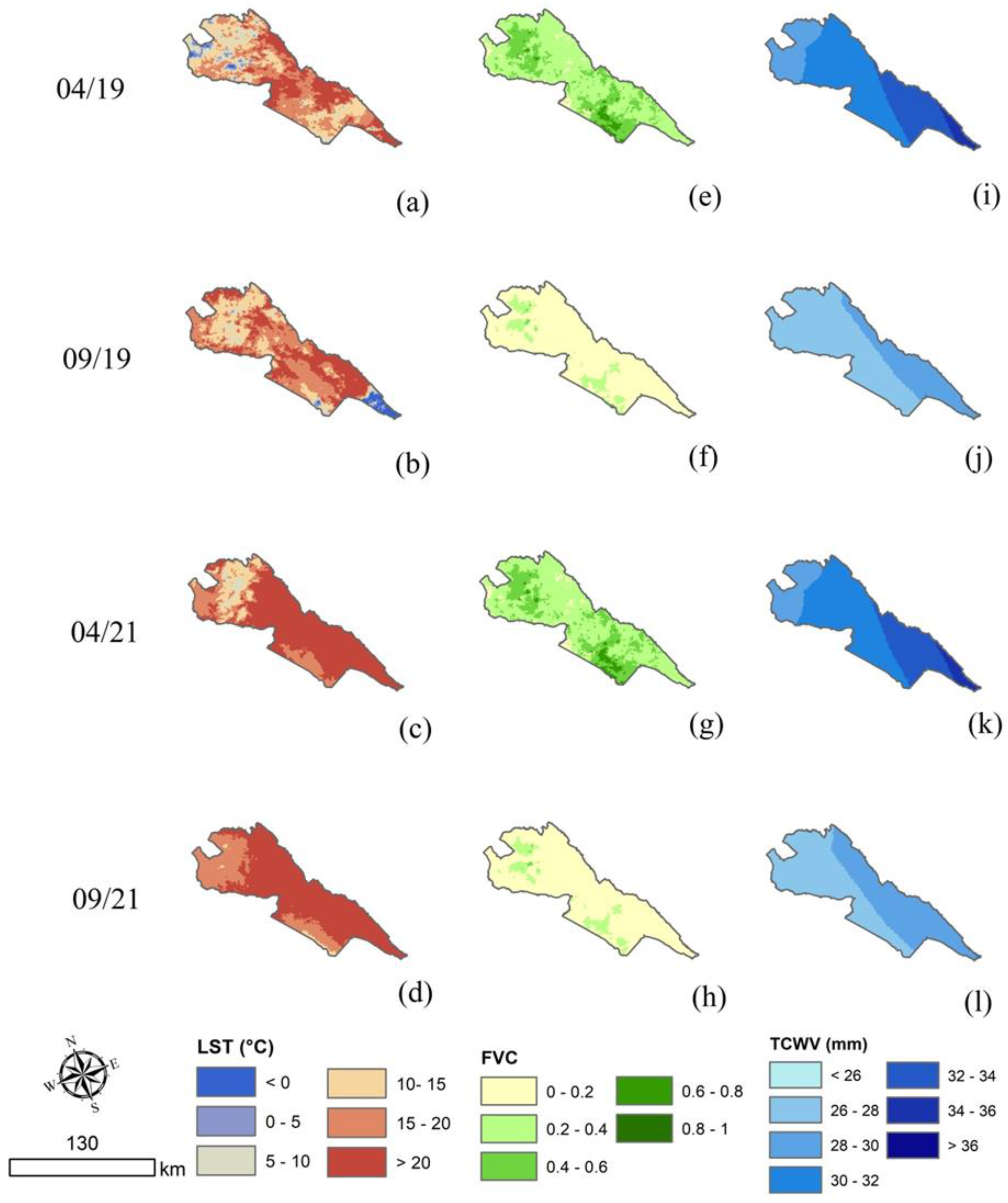

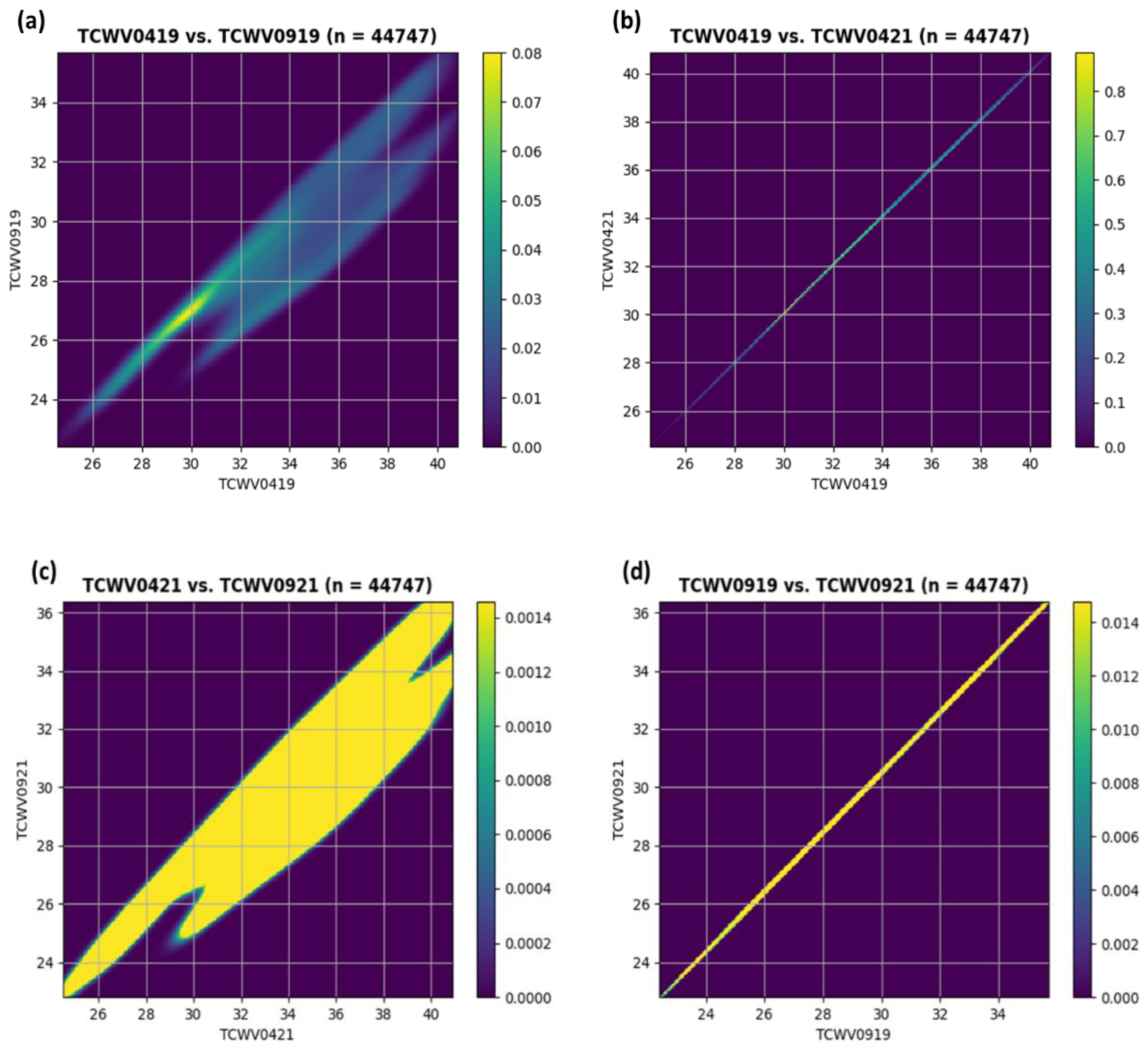
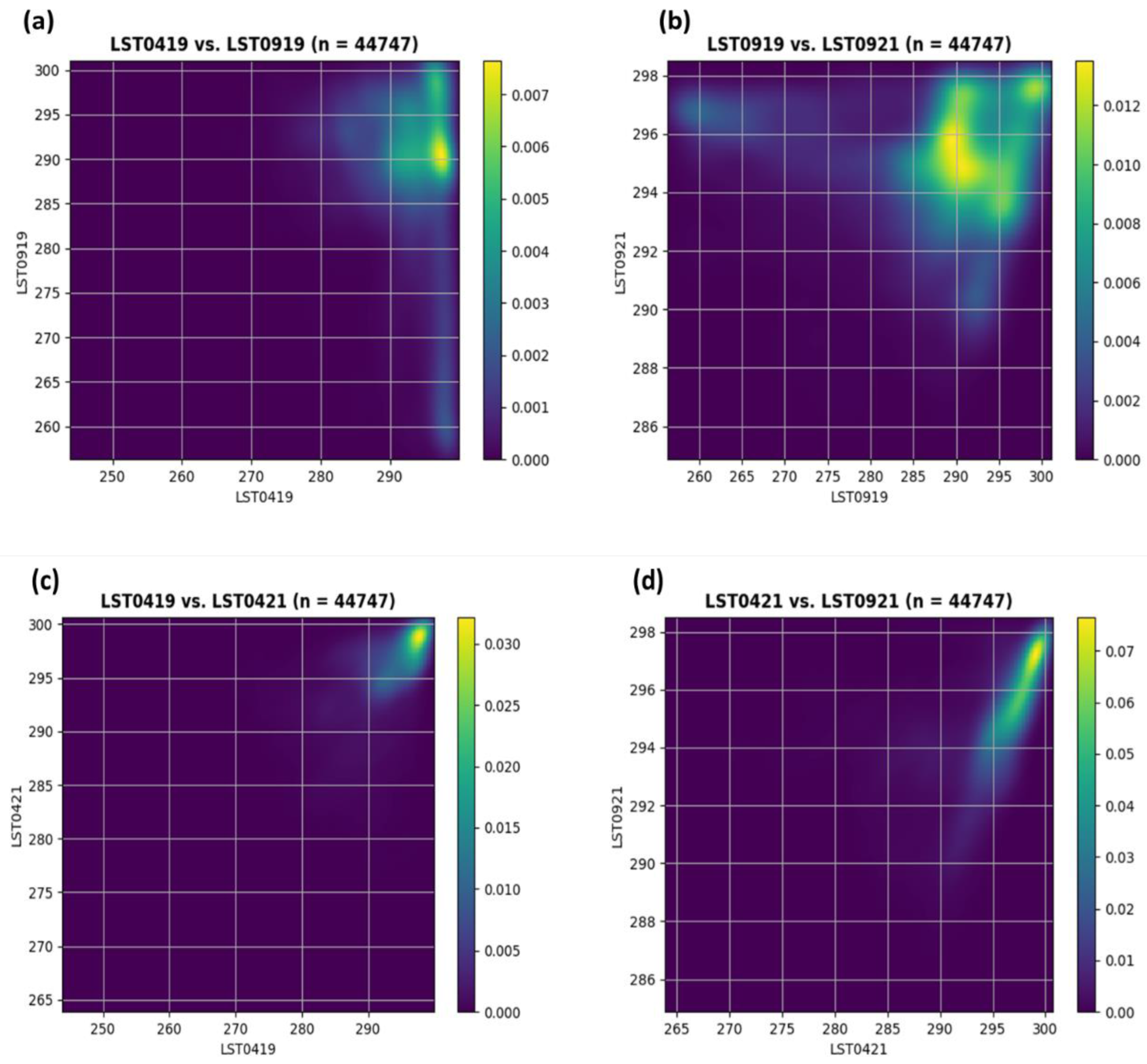
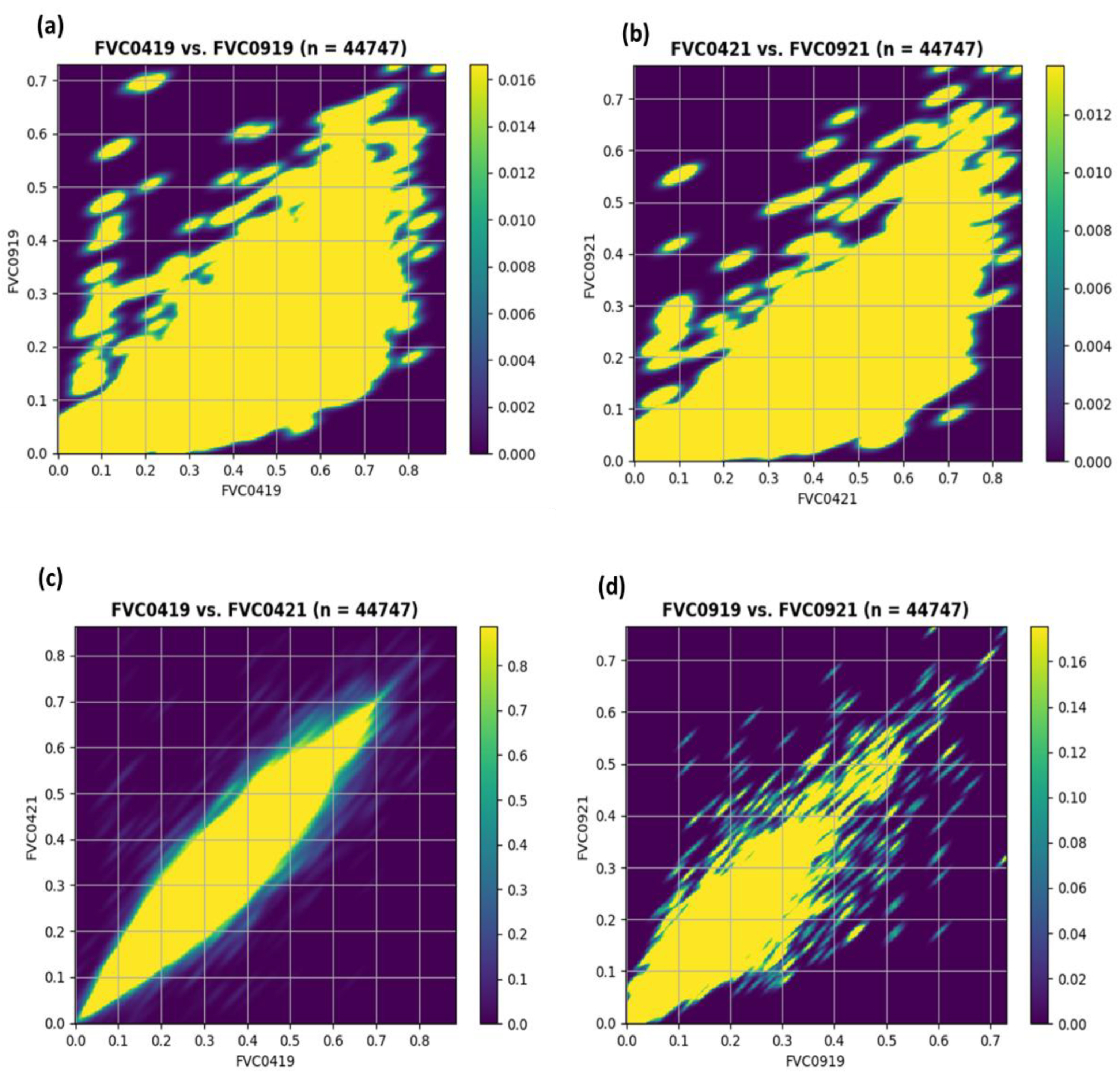
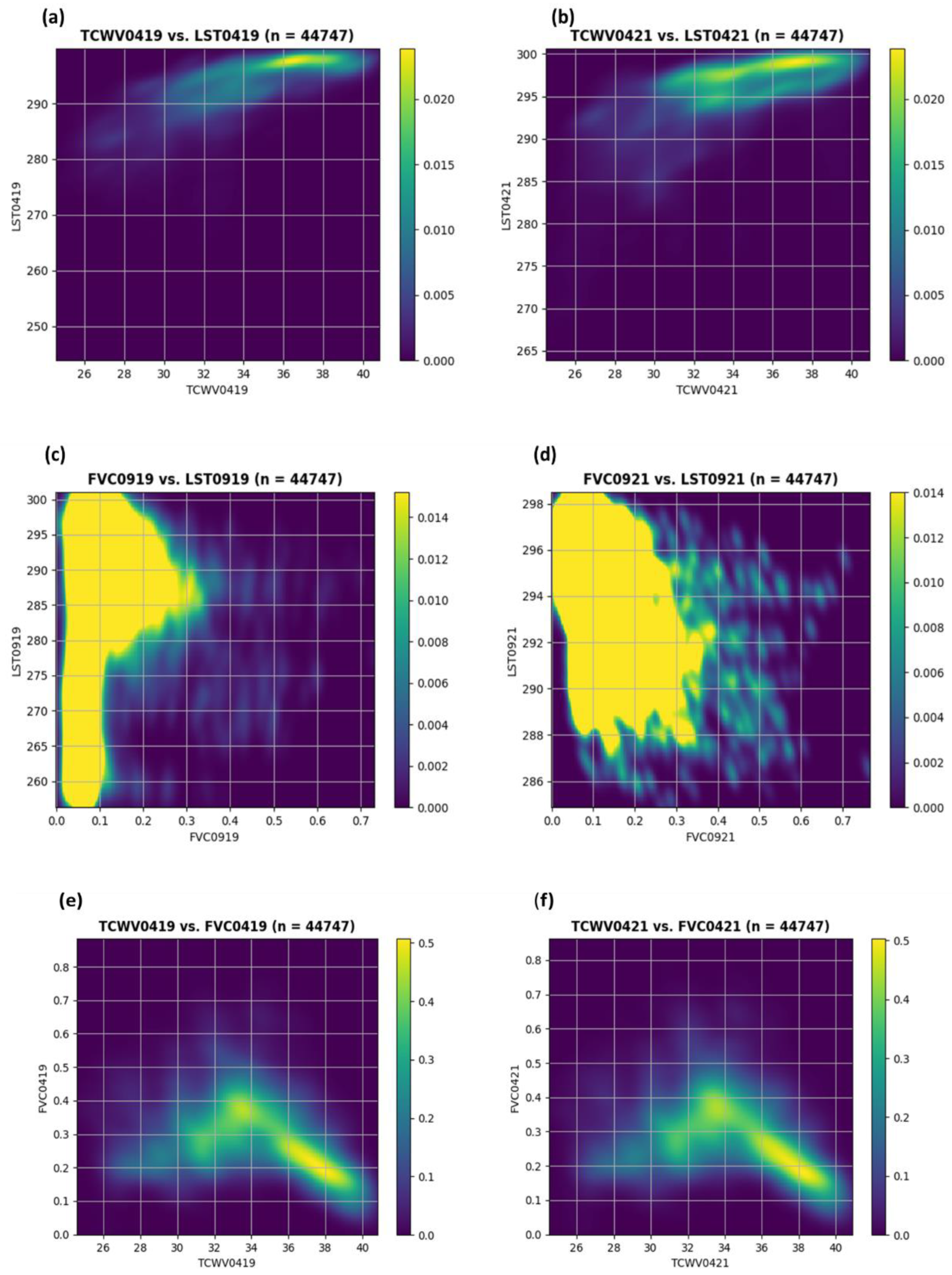
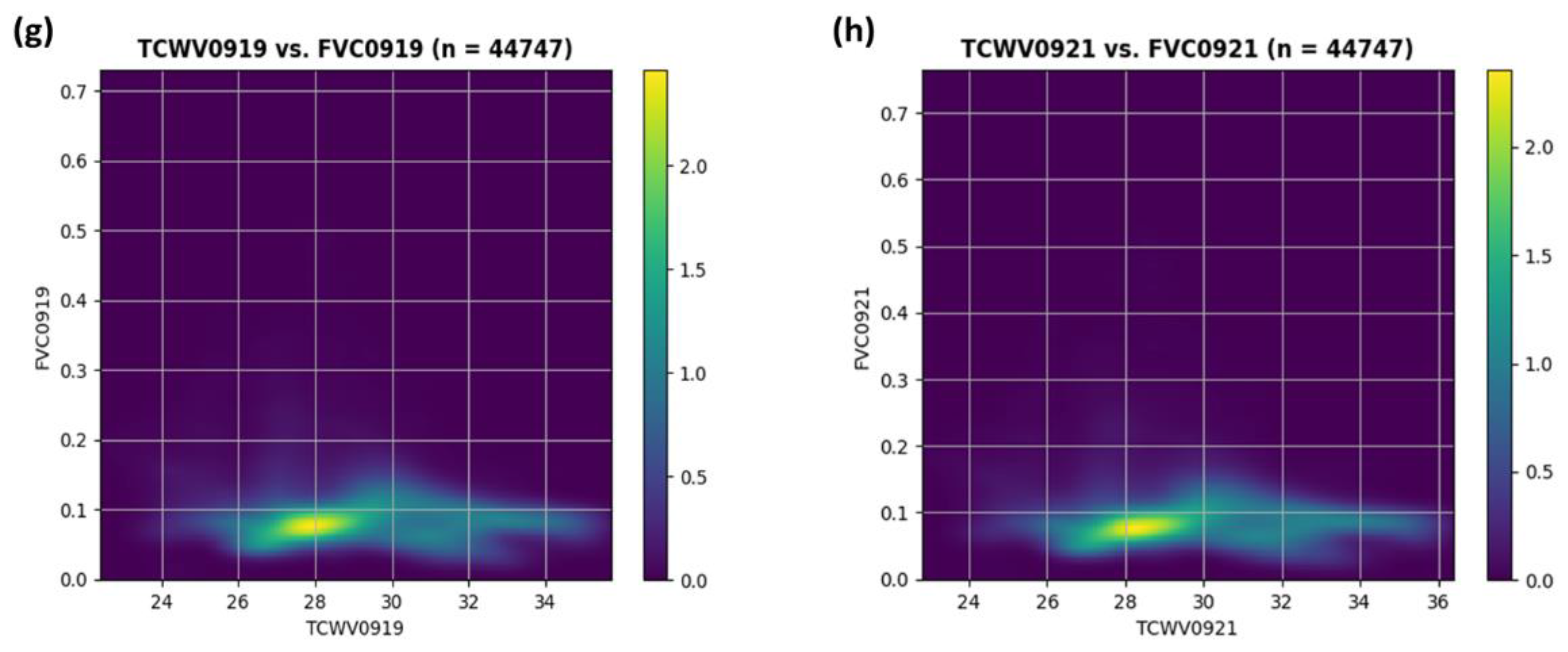
| Product ID | Sensing Date | Product Type | Satellite |
|---|---|---|---|
| S3B_SL_2_LST____20190404T195009_20190404T195208_20200819T213324_0119_024_013_5940_LR1_R_NT_004 | 4 April 2019 | SL_2_LST | S3B |
| S3B_SL_2_LST____20190925T193849_20190925T194049_20200821T053318_0119_030_184_5940_LR1_R_NT_004 | 25 September 2019 | SL_2_LST | S3B |
| S3B_SL_2_LST____20210402T195015_20210402T195214_20210404T053006_0119_051_013_5940_LN2_O_NT_004 | 2 April 2021 | SL_2_LST | S3B |
| S3A_SL_2_LST____20210928T194837_20210928T195036_20210930T091149_0118_077_013_5940_LN2_O_NT_004 | 28 September 2021 | SL_2_LST | S3A |
Disclaimer/Publisher’s Note: The statements, opinions and data contained in all publications are solely those of the individual author(s) and contributor(s) and not of MDPI and/or the editor(s). MDPI and/or the editor(s) disclaim responsibility for any injury to people or property resulting from any ideas, methods, instructions or products referred to in the content. |
© 2023 by the authors. Licensee MDPI, Basel, Switzerland. This article is an open access article distributed under the terms and conditions of the Creative Commons Attribution (CC BY) license (https://creativecommons.org/licenses/by/4.0/).
Share and Cite
Musyimi, P.K.; Sahbeni, G.; Timár, G.; Weidinger, T.; Székely, B. Analysis of Short-Term Drought Episodes Using Sentinel-3 SLSTR Data under a Semi-Arid Climate in Lower Eastern Kenya. Remote Sens. 2023, 15, 3041. https://doi.org/10.3390/rs15123041
Musyimi PK, Sahbeni G, Timár G, Weidinger T, Székely B. Analysis of Short-Term Drought Episodes Using Sentinel-3 SLSTR Data under a Semi-Arid Climate in Lower Eastern Kenya. Remote Sensing. 2023; 15(12):3041. https://doi.org/10.3390/rs15123041
Chicago/Turabian StyleMusyimi, Peter K., Ghada Sahbeni, Gábor Timár, Tamás Weidinger, and Balázs Székely. 2023. "Analysis of Short-Term Drought Episodes Using Sentinel-3 SLSTR Data under a Semi-Arid Climate in Lower Eastern Kenya" Remote Sensing 15, no. 12: 3041. https://doi.org/10.3390/rs15123041
APA StyleMusyimi, P. K., Sahbeni, G., Timár, G., Weidinger, T., & Székely, B. (2023). Analysis of Short-Term Drought Episodes Using Sentinel-3 SLSTR Data under a Semi-Arid Climate in Lower Eastern Kenya. Remote Sensing, 15(12), 3041. https://doi.org/10.3390/rs15123041











